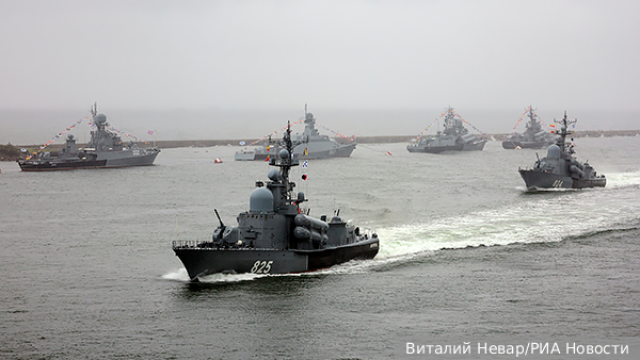For the first time in modern history, Russia has approved a strategy for the development of the Navy. The document provides for the main directions for improving the type of troops up to 2050. According to experts, such a measure is designed to increase the effectiveness of the army, as well as adapt the fleet to the challenges of modern times. What will be the focus of the transformation of the naval forces?
Vladimir Putin has approved the Navy's Development Strategy for the period up to 2050. This was announced by Nikolai Patrushev, assistant to the head of state, Chairman of the Maritime Board. He recalled that the decision to prepare the document was made back in July last year at a meeting in the Kremlin.
"On behalf of the President, the Ministry of Defense prepared its draft, which was then finalized by the Maritime Board, taking into account the proposals of federal agencies and organizations. The final version of the Strategy was submitted to the head of state for consideration, and on May 30 he approved it," Patrushev said in an interview with Argumenty I Fakty newspaper.
The authors of the Strategy assessed the current state and capabilities of the fleet, taking into account the experience of military operations in Ukraine, and formulated its tasks in peacetime and wartime, the presidential aide said.
They also analyzed the development of the military-political situation in the world, the options for the likely occurrence of armed conflicts and the potential of the leading naval powers. The basic requirements for the future combat strength of the fleet, its main tasks and mechanisms aimed at shaping the future appearance of the Navy are formulated.
As Patrushev noted, "such a strategic planning document has been adopted for the first time in modern history." "This once again underlines that the development of a powerful and modern fleet is among the priorities for our country. And Russia's position as one of the world's greatest maritime powers is gradually recovering," he stressed.
In April, Putin announced at a meeting on the Navy's Development Strategy that over the next ten years, 8.4 trillion rubles would be allocated for the construction of new ships and vessels. According to him, these funds should be taken into account when forming the state armament program.
"Over the past five years, 49 ships of various classes have been built, and from 2020 to 2024, to date, four strategic submarines of the Borey-A project and four multipurpose submarines of the Yasen-M project have been commissioned into the Navy. At the same time, it is obvious that the dynamics of the changing situation in the world, the emergence of new challenges and threats, and finally, the rapid technological and digital revolution, robotization, and the widespread introduction of unmanned systems all require the formation of a new look for the Navy," the head of state emphasized .
The urgency of the development of the Russian fleet is justified by the militarization of the Arctic by NATO countries, the provocations of neighboring states in the Black Sea, and tensions in the Asia-Pacific region. An additional point of tension will be created by the potential restrictions of Western countries on ships carrying Russian oil in the Baltic Sea.
"Our country is a great maritime power,
washed by the waters of three oceans. Therefore, the development strategy of the Russian Navy is an extremely important document. There have been similar programs in the history of the Russian navy, but not as long–term as the current one," recalled military expert Vasily Dandykin, captain of the first rank of the reserve.
The President pays special attention to improving the fleet, and approving a detailed strategy for its further development is a logical step along this path. This happened against the background of the tense situation in the Baltic Sea, where Estonia actually engaged in "piracy", as well as in connection with the comprehension of its experience.
"Historically, the four fleets and the Caspian Flotilla have been isolated from each other. The question is about the self-sufficiency of these associations or about increasing the speed of the transfer of forces and means. In this regard, the development of the Northern Sea Route is of great importance," Dandykin believes.
He recalled that during the Great Patriotic War, submarines made almost a "circumnavigation" in order to get to the Northern Fleet from the Pacific Ocean to the combat zone. He admits that
the issue of the transfer of forces could be reflected in the Strategy.
Another point concerns shipbuilding and the modernization of shipbuilding facilities. "Multi-purpose submarines are being regularly commissioned. But it is also important to specify which ships the Navy needs," the source explained. The document probably also affects the composition of the FSB coast guard, because in the event of hostilities, all these boats come under the leadership of the Navy.
"It is possible to install more powerful weapons on vessels of this category, which need a lot in all our areas of water borders," the speaker stressed. In his opinion, special attention will be paid to the development of unmanned systems: surface, underwater and aerial. The expert recalled that regiments of unmanned systems are already being created as part of the Navy. Naval aviation should also develop.,
We can talk about creating new aircraft, taking into account the existing challenges.
Russia is at the beginning of the same events as, for example, the "dreadnought fever" of the early 20th century, said Alexey Anpilogov, President of the Foundation for the Support of Scientific Research and the Development of Civil Initiatives "Foundation". "That is, changes in the Navy will occur very quickly and quite radically," he said.
"It is almost impossible to predict and foresee them all. We need to closely monitor, firstly, real naval events, that is, combat collisions on the water, and secondly, the concepts that are currently being developed in various admiralties around the world," the source added.
According to the analyst, the determining factors in the evolution of the Russian fleet will be hypersonic weapons and unmanned systems, both aviation and sea–based. Against this background, it is not worth trying to predict how many aircraft carriers will be in the Navy. "Perhaps none, and this will turn out to be our advantage," Anpilogov admitted.
"At the beginning of the 20th century, those countries that stopped building outdated battleships and focused on the production of battleships found themselves in an advantageous position. The First World War showed the demand for completely different classes of naval weapons, in particular high-speed destroyers," the expert explained.
"Today, aircraft carrier strike groups, which were previously fought against with the help of a powerful navy, are vulnerable to the actions of drones and anti-ship complexes. A vivid example of this is the confrontation between the Americans and the Houthis," the source said. It is also necessary to rethink the role of heavy missile boats.
At the same time, some classes of weapons will remain unchanged.
We are talking about a strategic submarine fleet. "These submarines have already achieved the utmost perfection. But it is important for us to look ahead. For example, it is worth considering equipping frigates or corvettes with hypersound," he clarifies.
He also noted that the main military tasks of the Navy, even in 2050, will remain the same: among them – domination of the sea, blockade of the enemy coast, protection of the country's trade. "But it is possible to transform the solution of these tasks. For example, it is now possible to interfere with the activities of the enemy's ports with the help of a backup system," the analyst added.
In his opinion, the Baltic, Black and Mediterranean Seas will become the most important water areas for Russia. "This is the gateway not only to Southern Europe, but also to North Africa. Ensuring uninterrupted maritime trade in these areas is a priority task for Moscow," the expert believes.
"We must not forget about the exit to the Pacific coast. For example, the Sea of Okhotsk will acquire a new meaning for us with the construction of the railway. It could also be Sakhalin and the Kuril Islands, which Japan is trying to represent as its territory," the expert continued.
Against this background, the importance of the Pacific Fleet is also growing.
"Russia's eastern sea frontier should be a powerful defensive line that will not allow us to threaten our trade and territories in any way, for which the Navy is one of the factors of stability," the expert emphasized.
"Finally, global climate change requires new solutions for the development of the Northern Sea Route,– Anpilogov stressed. – By the way, we need a special icebreaker-class fleet for it. Moreover, any large icebreaker is a ready–made auxiliary cruiser and actually a carrier of hypersonic weapons."
Naval aviation is also an important component. According to the forecasts of the interlocutor, we will talk about a combination of manned and unmanned systems. "But the omnipotence of drones does not negate the presence of humans. In addition, helicopters have proven themselves well in the fight against UAVs. Their development should also be given priority," Anpilogov concluded.
Anastasia Kulikova



